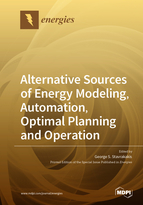Alternative Sources of Energy Modeling, Automation, Optimal Planning and Operation
A special issue of Energies (ISSN 1996-1073). This special issue belongs to the section "A: Sustainable Energy".
Deadline for manuscript submissions: closed (30 April 2022) | Viewed by 24279
Special Issue Editor
Interests: alternative (renewable) energy sources modeling and automation; production systems automation; decision support systems; systems safety and reliability analysis; real-time industrial processes fault monitoring and diagnosis; building energy management systems
Special Issues, Collections and Topics in MDPI journals
Special Issue Information
Dear Colleagues,
Formulation of computer implemented models of alternative (renewable) sources of energy (ASE or RES) will help in the proper allocation of widely available renewable energy sources, but they are also absolutely necessary to design and implement efficient automation for optimal operation of ASE (RES) plants and installations. Detailed simulation of alternative sources of energy devices and integrated power plants may be a very cost-effective solution, and very often, several subsystems of an integrated ASE (RES) power plant might be inappropriate, difficult to find, and/or very expensive. Further, ASE (RES) potential forecasts are essential to the integration of renewable power generation in electricity markets operations, since markets ought to be cleared in advance, while market participants shall then make decisions even before that happens. This Special Issue, entitled “Alternative Sources of Energy Modeling and Automation”, was proposed for the international journal Energies, which is an SSCI and SCIE journal (Impact Factor of 2.676 for 2017), to cover original research and scientific contributions related to the abovementioned topics, including the most usual ASE (RES) small electric power plants, such as wind, small hydro, geothermal, biomass, tidal, photovoltaic, fuel cells, batteries, hybrid plants, etc. As an example, in order to design integrated smart power grids based on ASE (RES) with battery-based storage, very good ASE (RES) component behavioral model and automation of the integrated system is necessarily required.
Papers selected for this Special Issue will be subject to a rigorous peer review procedure, with the aim of rapid and wide dissemination of research results, developments, and applications.
I am writing to invite you to submit your original work to this Special Issue. I look forward to receiving your outstanding research.
Prof. Dr. George S. Stavrakakis
Guest Editor
Manuscript Submission Information
Manuscripts should be submitted online at www.mdpi.com by registering and logging in to this website. Once you are registered, click here to go to the submission form. Manuscripts can be submitted until the deadline. All submissions that pass pre-check are peer-reviewed. Accepted papers will be published continuously in the journal (as soon as accepted) and will be listed together on the special issue website. Research articles, review articles as well as short communications are invited. For planned papers, a title and short abstract (about 100 words) can be sent to the Editorial Office for announcement on this website.
Submitted manuscripts should not have been published previously, nor be under consideration for publication elsewhere (except conference proceedings papers). All manuscripts are thoroughly refereed through a single-blind peer-review process. A guide for authors and other relevant information for submission of manuscripts is available on the Instructions for Authors page. Energies is an international peer-reviewed open access semimonthly journal published by MDPI.
Please visit the Instructions for Authors page before submitting a manuscript. The Article Processing Charge (APC) for publication in this open access journal is 2600 CHF (Swiss Francs). Submitted papers should be well formatted and use good English. Authors may use MDPI's English editing service prior to publication or during author revisions.
Keywords
- Alternative/renewable sources of energy (ASE/RES) modeling and computer simulation
- Alternative /renewable sources of energy (ASE/RES) automation
- Solar thermal energy computer modeling and automation
- Photovoltaic (PV) energy computer modeling, automation, optimal planning and operation, especially applied to autonomous PV installations
- Fuel Cells, hydrogen, batteries, and energy storage in general modeling, automation, optimal planning and operation
- Wind energy modeling, automation, optimal planning and operation
- Biomass, biofuels, biogas, gazification, bioenergy in general, modeling and automation
- Tidal systems models and automation
- Geothermal systems models and automation
- Waste to energy modeling, automation, optimal planning and operation
- Hybrid ASE/RES models and automation
- ASE/RES and hybrid power system optimization
- ASE/RES and smart micro grids integration optimization
- Alternative/renewable sources of energy (ASE/RES) forecasting and optimal planning
- ASE/RES models and automation based on artificial neural networks, fuzzy logic, neuro-fuzzy methods, machine learning and Artificial Intelligence (AI) methods
- Optimization methods applied in ASE/RES planning and/or optimal operation and grid integration
- Decision support systems (DSS) applied in ASE/RES planning and/or optimal operation and grid integration






